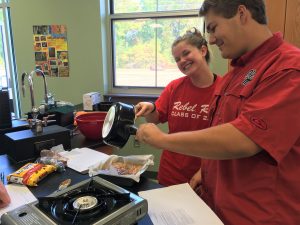
Madeleine Mixon (left) and Cole Bofrek prepare caramel for their chocolate bar. Photo by Brenda Prager
Chemical engineering students enrolled in Ch E 101: Introduction to Chemical Engineering were required midway through the semester to use their cooking expertise to prepare a Snickers bar. Why, you might ask?
After observing the strengths and pitfalls of carefully preparing caramel dispersed with roasted peanuts, and mixing nougat to the correct consistency with a scrumptious peanut butter flavor, the freshmen investigated in depth a chocolate bar manufacturing process.
Many were surprised to learn that everyday items often taken for granted were part of an intricate chemical process. They learned that food manufacturing requires careful planning of unit operations and their order within the overall process, as well as accurate control of many variables (particularly temperature) within each step.
Students worked in groups of four, learning valuable teamwork skills, which included the inevitable compromise and dealing with conflict and, of course, an overall enriching experience and greater depth of learning through collaboration.
Writing up a practical report was a first-time experience for many students. Not only were they required to describe the chocolate bar preparation, but they also had to consider likely equipment items, draw process flow sheets, and conduct basic chemical engineering calculations such as flow rate and average molecular weight of the nougat stream.
“This project was a very fun endeavor, as it allowed me and my group to indulge some delicious treats while also applying scientific methods and analytics to our process,” said Walker Abel, one of the students.
After working in both industry and academia as a chemical engineer, I first learned about Differentiated Teaching and Learning when I completed an M. Teach (secondary) from the University of Melbourne, and subsequently taught high school chemistry, physics and mathematics for five years. Coming back into academia and chemical engineering, I decided to implement these techniques into my freshman classes in order to present students with a more targeted education that best matched their learning needs. This method of teaching is common in many K-12 settings but underutilized at the university level.
Freshmen often come from varied backgrounds and different high school experiences, and it is important that their first year adapts to their needs and assists in progression of both learning and retention. Differentiation is characterized by a) understanding student need; b) presenting concepts in multiple ways; c) providing challenging learning experiences; d) promoting collaborative tasks; and e) progressing students into independent learners.
By successfully preparing students with these skills in their freshman year, they are more likely to thrive in later years and proceed to completion of their course.
Through the Snickers bar project, students learned new chemical engineering skills and reviewed most of the engineering calculations covered previously within the course as well. Throughout the project, students were required to make decisions and judgments about various sections of their written reports, providing real-life experiences of working in teams and becoming independent learners.
“As a team, we achieved our goal of making the bar, as well as applying the techniques that we used in the preparation of the candy bar in a large-scale setting,” Abel said.
The semesterlong course contained targeted instruction covering the five points described above. Formal feedback from students upon completion of the course showed important progress in the implementation of differentiated learning at a college level. For example, 83 percent of the class found active reading and problem-solving study skills sessions extremely or very useful; and 87 percent used the differentiated homework sheets to challenge themselves or choose questions matching their current ability level.
With respect to the chocolate bar project, 70 percent learned a lot about cooperation and compromise within a group setting; almost 60 percent were more confident with engineering calculations encountered earlier in the semester; and 87 percent learned – as a team – the key points in writing a technical report.
Research in this area is important to pursue. It is vital that students receive a targeted education to meet their needs and successfully graduate. STEM education is important for the nation, and although improvements have been made, a 2016 report showed that attracting high school students to STEM education in college remains a challenge. The students in STEM courses must be cultivated and encouraged from day one, so teaching and learning strategies that are targeted to students’ needs is an important step in attracting more students into these areas.
Brenda Prager is an assistant professor of chemical engineering in the UM School of Engineering.